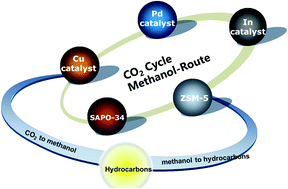The development of bifunctional catalysts for carbon dioxide hydrogenation to hydrocarbons via the methanol route: from single component to integrated components
Abstract
Hydrocarbon utilisation results in the emission of a large amount of CO2, while crude oil as the conventional source of hydrocarbons will eventually be depleted. These problems can both be potentially solved via a bifunctional catalytic system with integrated components that can directly convert CO2 into hydrocarbons. There are two possible reaction pathways involved in this catalytic system, but compared to the reverse water gas shift-Fischer Tropsch synthesis (RWGS-FTS) route, the methanol route potentially has a higher selectivity of desired products due to its ability to overcome the restriction of the Anderson–Schulz–Flory (ASF) distribution. The methanol route requires bifunctional catalysts consisting of metal/metal oxide and zeolite components. The former is used to convert CO2 into methanol, whereas the latter is used to convert methanol into hydrocarbons. This review first discusses the development of metal/metal oxide single component catalysts to enhance the hydrogenation of CO2, methanol selectivity, and methanol yield. Next, the development of zeolite single-component catalysts for the methanol to hydrocarbon (MTH) reaction by minimising coke formation and tuning the hydrocarbon selectivity is discussed, and finally the development of integrated bifunctional catalysts via the methanol route is introduced. Overall, although bifunctional catalytic systems can successfully achieve the desired product selectivity for all hydrocarbons, they suffer from high CO selectivity at a high operating temperature, which needs to be addressed to enhance the yield and selectivity of a specific hydrocarbon. At this stage, it could not be confirmed if bifunctional catalytic systems can effectively decrease the CO2 content globally, while acting as an effective alternative hydrocarbon source until a complete life cycle analysis is conducted. Nevertheless, it can be concluded that bifunctional catalytic systems demonstrate much better potential and benefits than separate multi-step catalysts in different reactors because under the same reaction conditions, bifunctional catalysts demonstrate higher CO2 conversion and lower CO selectivity than single metal/metal oxide catalysts and longer catalyst lifetimes than single zeolite catalysts, while maintaining selectivity for desired hydrocarbon products.



 Please wait while we load your content...
Please wait while we load your content...